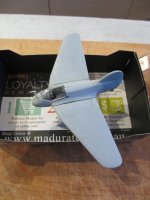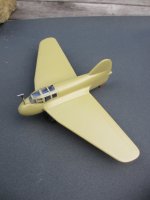Hazebrouck
Sergeant
- Joined
- Aug 30, 2010
- Messages
- 622
Looking for some advice from the aero modellers.
I am working on a little German experimental jet (DFS-194) in 1/72 made by PM. The canopy is very thin and the frame lines are etched flat into the moulding and are difficult to see. I normally hand paint canopy frames (most have raised detail) and glue with PVA after painting the body of the plane. I am a bit wary of making a mess of the canopy hand brushing, however with the lack of raised frame detail it looks difficult to mask with tape accurately either.
Gut feeling is to mask canopy, glue in place and paint (airbrush) in one go. Hoping that PVA might close up the small gaps around the canopy as well.
Any thoughts?
I am working on a little German experimental jet (DFS-194) in 1/72 made by PM. The canopy is very thin and the frame lines are etched flat into the moulding and are difficult to see. I normally hand paint canopy frames (most have raised detail) and glue with PVA after painting the body of the plane. I am a bit wary of making a mess of the canopy hand brushing, however with the lack of raised frame detail it looks difficult to mask with tape accurately either.
Gut feeling is to mask canopy, glue in place and paint (airbrush) in one go. Hoping that PVA might close up the small gaps around the canopy as well.
Any thoughts?




